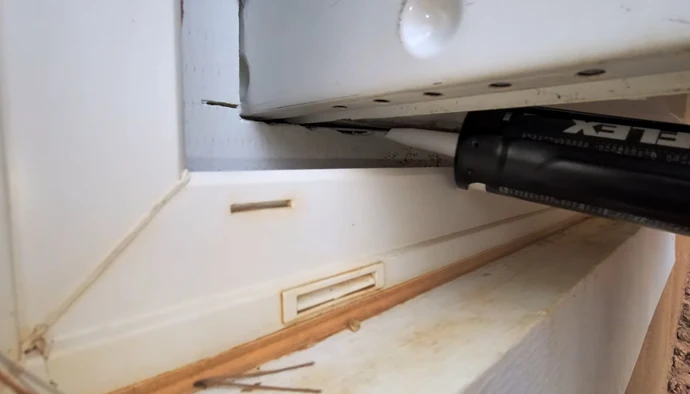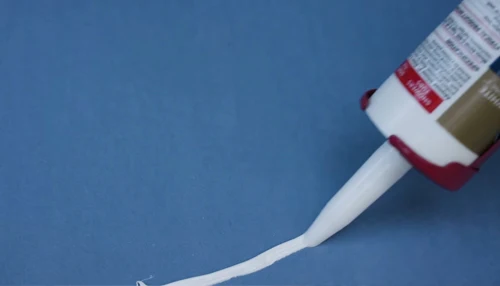Last Updated on December 25, 2022
If you’re wondering how to caulk in tight spaces, here are some tips that will help you get started. Before you begin, it’s a good idea to make a shopping list and pick up the materials you need in advance.
Having everything you need on hand before you start the project will help you avoid interruptions. This way, you can stay in the flow and still achieve great results.
Cleaning the area and preparing it for caulking is an essential part of any DIY project, so be sure to do this too. To remove the old sealant, use a safety razor or painter’s tape.
Tip for applying caulk in tight spaces
When applying caulk in tight spaces, your gun’s spout may be clogged or partially empty. This can make the caulk difficult to apply, and a screw to clear out the spout can be extremely helpful.
Also, if the crack is large, you may need to make a second pass, using a caulk gun with a larger hole. When applying caulk to a crack, move the tip of the gun along the crack quickly and evenly to avoid streaks or other mistakes.
To ensure a smooth finish, use a latex glove and clean rags to clean the area before caulking. If you have a mold or have a tight spot, a small amount of silicone caulk is sufficient to seal the space.
For corners, try shaping the caulk into a sharp, clean corner joint. A smooth corner joint is easier to paint over. Before applying caulk around a bathtub, sink, or shower, it’s important to remove any soap scum or other contaminants.
If you’re an experienced do-it-yourselfer, you’ve probably used caulk before. It’s one of those skills that every DIYer should have on their toolbox.
The good news is that there are numerous ways to use this handy material. Besides giving your home an instant facelift, caulking can improve your home’s energy efficiency and curb appeal.
It can be used for anything from repairing a minor roof to resticking peeling wallpaper. The technique depends on the type of caulk you’re using.
If you’re having trouble applying caulk in tight spaces, try using a flexible drinking straw. It will help you control the bead’s size at any angle. You can also use a painter’s tape to hold the straw into place.
Using this method, you’ll be able to work on small projects with the help of caulk, but it’s best to get a professional for more difficult jobs.
If you don’t have a caulking gun, you can also try a tip that allows you to apply caulk without a gun. A tip cut at a 45-degree angle will prevent the caulk from drying out too quickly.
To avoid a drip, place a nail into the caulk tube’s nozzle. Once you’ve placed the nail into the caulk tube, wrap it in plastic or aluminum foil to prevent it from drying out.
Types of caulk
There are different types of caulk for tight spaces, and the right one for your project depends on the area to be sealed. Some are suitable for sealing joints, while others are designed specifically for outdoor use.
Whatever your situation, there’s a caulk for the job that’s right for you. Silicone caulk is an excellent choice for sealing joints between brickwork and concrete, stucco, and outdoor infrastructure like gutters and flashing.
However, this type of caulk can be messy and irritating to work with, so you may want to avoid this type of caulk unless it’s necessary.
When choosing the right type of caulk, make sure you understand the different properties of each type. Acrylic latex caulk is a great choice for masonry, wood, and drywall, as it has an even texture, and it’s easy to apply.
Although it’s better suited to interior applications, it can be very slow to reach its full cure. When used properly, it can last as long as 15 years.
However, you should use caution when using this type of caulk, since sudden temperature changes and moisture can affect its durability.
When choosing a caulk, consider the job’s complexity and purpose. For example, silicone caulk is ideal for sealing large gaps, but can’t be painted.
An unsanded version, on the other hand, will seal surfaces that have a rougher texture. If you’re using silicone caulk in a kitchen, make sure to use a tool with a large, flat surface, such as a spoon.
There are several types of caulk, including polyurethane, butyl, and silicone. When choosing a caulk for tight spaces, make sure you have clean surfaces and are using the right technique for the job.
You should also ensure that the temperature of the caulk is right. Finally, make sure to read instructions carefully before you start applying it. If you don’t want it to come off too thick, you can always use painter’s caulk.
Silicone is a versatile type of caulk. Unlike latex caulk, silicone is waterproof and flexible. It is also a great choice if the area is likely to get wet, as it won’t be exposed to paint and may be more expensive than latex. However, silicone isn’t paintable, and its cleanup is messy. Silicone is only available in neutral colors.
Cost of caulk
The cost of caulk in tight spaces can vary depending on the type and condition of the surface that needs sealing. In some cases, the surface can be damaged by shearing forces and requires a more thorough sealing process.
Other areas may require special properties like heat and moisture resistance, which could increase the cost. Some jobs may also require access to tight spaces, such as crawl spaces. To determine the exact cost, you should get several bids from different companies.
Homeowners should consider the cost of caulking if they plan on doing some renovations. Caulking a single window or door can range from $150 to $500.
Choosing a professional for the job can save you money and give you crisp lines. However, if you have a difficult job that requires a precise application, you may want to opt for a do-it-yourself caulking project.
While caulking isn’t dangerous, it is frustrating. Before starting the project, make sure to set aside a space that is free of obstructions. Make sure that you have a child-proof barrier and another person to watch over the job. The cost of caulking can be high if you have no experience.
However, it will be well worth it in the long run. This is because caulking can also cost you money if you don’t know how to use the right tools.
The cost of caulking in tight spaces depends on the number of cartridges you need. If the room you’re working on is 10 x 10 feet, you’ll need one or two cartridges of caulk.
Always purchase more than you’ll need. That way, you can save the rest for later. You may need it for other projects as well. If you are looking for inexpensive caulk, consider investing in a high-quality caulking gun.
Painter’s caulk is an acrylic latex compound. It’s perfect for small projects around the house, but it’s not a great choice for wide gaps and joints.
If you’re looking for a more permanent solution, you may want to use silicone caulk. Silicone caulk, on the other hand, is a stronger type that provides a stronger moisture barrier. Putty is like a soft cement and is hand-moldable.
Energy efficiency benefits of caulking
Using caulk to seal air leaks around heating and cooling system vents and fresh-air supply vents for fuel-burning furnaces and water heaters is an excellent way to prevent the loss of energy from the home.
Wood storm windows that do not contain screens in the spring can be sealed with a non-permanent rope caulk. Similarly, storm doors made of wood should be sealed with a storm door.
The best caulk for sealing damp areas is one that withstands changes in temperature and moisture. You can buy caulk specially formulated for damp areas, which is mold resistant.
Silicone blend caulks are the most common type of caulk used for kitchen and bath projects. They are especially suitable for installing bath fixtures and can be used around sinks and tubs. There are also latex caulks that are 100% waterproof.
Another type of caulk is made of polyurethane, which is extruded through a straw. This sealant has excellent insulation and sealing properties. It can also be used for sound-dampening purposes.
Pest-resistant foam sealants are also available for sealing exterior holes and gaps. These sealants can also deter rodents and increase soundproofing builds. While caulking is effective, it can be difficult to apply properly and may require further repair.
The use of foam spray or caulk is an excellent way to seal air leaks in basements. Basements are notorious for leaking air, especially because of their colder temperatures.
Cracks in brick and stone can also be sealed with foam or expanded liquid foam. Expansive liquid foam can also be used to seal gaps around dryer vents and exhausts. So, caulking in tight spaces can provide significant energy efficiency.
Frequently Asked Questions (FAQs)
-What is the best type of caulk to use in tight spaces?
The best type of caulk to use in tight spaces is a siliconized acrylic caulk.
-How do you apply caulk in tight spaces?
You can apply caulk in tight spaces by using a caulk gun with a tube of caulk. Insert the tube of caulk into the caulk gun, cut the tip of the tube at an angle, and then squeeze the trigger to release the caulk.
-What are some tips for getting a good seal in tight spaces?
Some tips for getting a good seal in tight spaces are to use a putty knife or another thin, flat tool to help apply pressure evenly, use painter’s tape to help keep a consistent seal, and to avoid using too much caulk.
Final Words
One of the best ways to caulk in tight spaces is to use a caulk gun with a long tube. This will allow you to get into tight spaces and apply the caulk evenly.



